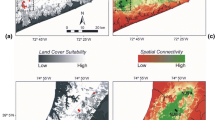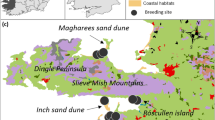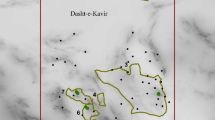Abstract
Context
Identification of areas with high connectivity is crucial for large carnivores’ management and conservation, especially where landscape has been modified by human activities. Partially under legal hunting control, south-central Argentine pumas (Puma concolor) have been described to be structured into two distinct groups with an inverse correlation between gene flow and hunting pressure.
Objectives
To further assess puma genetic structure and test whether isolation-by-distance and/or isolation-by-resistance could explain the previously reported putative correlation between gene flow and hunting pressure.
Methods
We explored spatial segregation of pumas by testing for hierarchical structure within previously identified clusters, genetic differentiation among sampling regions, and isolation-by-distance among individuals. Using a land cover resistance-based approach, we assessed landscape influence on puma connectivity to analyze landscape permeability between sampling sites.
Results
Our study added a third genetic group to the previously identified clusters, reporting significant genetic differentiation among sampling regions. We also observed a significant correlation among geographic and genetic distances, supporting genetic structure and gene flow pattern of connectivity. We identified a continuous high current flow across the landscape where shrublands are the primary habitat, whereas landscape permeability declined as grassland cover increases.
Conclusions
Genetic structure and gene flow among south-central Argentine pumas can be partially related to the landscape connectivity pattern observed in the area. These results are extremely important for puma conservation in the area because the identification of high-permeability linkage zones can now be used to gather ecological fine-scale data to support more appropriate conservation strategies, aiming to preserve important dispersal areas for this apex predator.




Similar content being viewed by others
References
Anderson CR, Lindzey FG (2005) Experimental evaluation of population trend and harvest composition in a Wyoming cougar population. Wildl Soc Bull 33:179–188
Anderson CR, Lindzey FG, McDonald DB (2004) Genetic Structure of Cougar Populations Across the Wyoming Basin: Metapopulation or Megapopulation. J Mammal 85:1207–1214
Andreasen AM, Stewart KM, Longland WS et al (2012) Identification of source-sink dynamics in mountain lions of the Great Basin. Mol Ecol 21:5689–5701
De Angelo C, Llanos R, Guerisoli M de las M, et al (2019) Puma concolor. In: Categ. 2019 los mamíferos Argentina según su riesgo extinción. https://cma.sarem.org.ar/es/especie-nativa/puma-concolor. Accessed 4 Jul 2020
Balasubramaniam KN, Bliss-Moreau E, Beisner BA et al (2021) Addressing the challenges of research on human-wildlife interactions using the concept of coupled natural & human systems. Biol Conserv 257:109095
Baldi R, Novaro A, Funes M et al (2010) Guanaco management in Patagonian rangelands: a conservation opportunity on the brink of collapse. In: Du Toit J, Kock R, Deutsch J (eds) Conserving Wildlife while Maintaining Livestock in Semi-Arid Ecosystems. Blackwell Publishing, Oxford, pp 266–290
Balkenhol N, Holbrook JD, Onorato D et al (2014) A multi-method approach for analyzing hierarchical genetic structures: a case study with cougars Puma concolor. Ecography 37:552–563
Blecha KA, Boone RB, Alldredge MW (2018) Hunger mediates apex predator’s risk avoidance response in wildland–urban interface. J Anim Ecol 87:609–622
Brown A, Martinez Ortiz U, Acerbi M, Corcuera J (eds) (2006) La Situación Ambiental Argentina 2005. Fundación Vida Silvestre Argentina, Buenos Aires
Castilho CS, Marins-Sá LG, Benedet RC, Freitas TO (2011) Landscape genetics of mountain lions (Puma concolor) in southern Brazil. Mamm Biol 76:476–483
Castilho CS, Marins-Sá LG, Benedet RC, Freitas TRO (2012) Genetic structure and conservation of mountain lions in the South-Brazilian Atlantic Rain Forest. Genet Mol Biol 35:65–73
Creel S, Rotella JJ (2010) Meta-analysis of relationships between human offtake, total mortality and population dynamics of gray wolves (Canis lupus). PLoS ONE 5:e12918
Crooks KR, Burdett CL, Theobald DM et al (2011) Global patterns of fragmentation and connectivity of mammalian carnivore habitat. Philos Trans R Soc B Biol Sci 366:2642–2651
Cushman SA, Mckelvey KS, Hayden J, Schwartz MK (2006) Gene flow in complex landscapes: testing multiple hypotheses with causal modeling. Am Nat 168:486–499
Del Valle HF, Elissalde NO, Gagliardini DA, Milovich J (1998) Status of desertification in the Patagonian region: assessment and mapping from satellite imagery. Arid Soil Res Rehabil 12:95–121
Delibes M, Gaona P, Ferreras P (2001) Effects of an attractive sink leading into maladaptive habitat selection. Am Nat 158:277–285
Dickson BG, Jenness JS, Beier P (2005) Influence of vegetation, topography, and roads on cougar movement in Southern California. J Wildl Manage 69:264–276
Dickson BG, Roemer GW, McRae BH, Rundall JM (2013) Models of regional habitat quality and connectivity for pumas (Puma concolor) in the Southwestern United States. PLoS ONE. https://doi.org/10.1371/journal.pone.0081898
Dolrenry S, Stenglein J, Hazzah L et al (2014) A metapopulation approach to African lion (Panthera leo) conservation. PLoS ONE 9:e88081
Earl DA, vonHoldt BM (2012) Structure harvester: a website and program for visualizing structure output and implementing the Evanno method. Conserv Genet Resour 4:359–361
Elbroch L, Wittmer H (2012) Puma spatial ecology in open habitats with aggregate prey. Mamm Biol 77:377–384
Elbroch M, Wittmer HU, Saucedo C, Corti P (2009) Long-distance dispersal of a male puma (Puma concolor puma) in Patagonia. Rev Chil Hist Nat 82:459–461
Ernest HB, Boyce WM, Bleich VC et al (2003) Genetic structure of mountain lion (Puma concolor) populations in California. Conserv Genet 4:353–366
Ernest HB, Vickers TW, Morrison SA et al (2014) Fractured genetic connectivity threatens a Southern California puma (Puma concolor) population. PLoS ONE. https://doi.org/10.1371/journal.pone.0107985
Fahrig L, Merriam G (1994) Conservation of fragmented populations. Conserv Biol 8:50–59
Frankham R (2006) Genetics and landscape connectivity. In: Crooks KR, Sanjayan M (eds) Connectivity conservation. Cambridge University Press, Cambridge, pp 72–96
Frantz AC, Cellina S, Krier A et al (2009) Using spatial Bayesian methods to determine the genetic structure of a continuously distributed population: clusters or isolation by distance? J Appl Ecol 46:493–505
Gallo O, Castillo DF, Godinho R, Casanave EB (2020) Genetic diversity, population structure, and immigration, in a partially hunted puma population of south-central Argentina. J Mammal 101:766–778
Golluscio RA, Deregibus VA, Paruelo JM (1998) Sustainability and range management in the Patagonian steppes. Ecol Austral 8:265–284
Guillot G, Mortier F, Estoup A (2005) Geneland: a computer package for landscape genetics. Mol Ecol Notes 5:712–715
Guillot G, Renaud S, Ledevin R et al (2012) A Unifying Model for the Analysis of Phenotypic, Genetic, and Geographic Data. Syst Biol 61:897–911
Gustafson KD, Vickers TW, Boyce WM, Ernest HB (2017) A single migrant enhances the genetic diversity of an inbred puma population. R Soc Open Sci. https://doi.org/10.1098/rsos.170115
Gustafson KD, Gagne RB, Vickers TW et al (2019) Genetic source–sink dynamics among naturally structured and anthropogenically fragmented puma populations. Conserv Genet 20:215–227
Hawley JE, Rego PW, Wydeven AP et al (2016) Long-distance dispersal of a subadult male cougar from South Dakota to Connecticut documented with DNA evidence. J Mammal 97:1435–1440
Holmes BR, Laundré JW (2006) Use of open, edge and forest areas by pumas Puma concolor in winter: are pumas foraging optimally? Wildlife Biol 12:201–209
Jackson VL, Laack LL, Zimmerman EG (2005) Landscape metrics associated with habitat use by ocelots in South Texas. J Wildl Manage 69:733–738
Johnson JA, Bellinger MR, Toepfer JE, Dunn P (2004) Temporal changes in allele frequencies and low effective population size in greater prairie-chickens. Mol Ecol 13:2617–2630
Jombart T (2008) Adegenet: A R package for the multivariate analysis of genetic markers. Bioinformatics 24:1403–1405
Jombart T, Devillard S, Balloux F (2010) Discriminant analysis of principal components: a new method for the analysis of genetically structured populations. BMC Genet. https://doi.org/10.1186/1471-2156-11-94
Jorge MLSP, Galetti M, Ribeiro MC, Ferraz KMPMB (2013) Mammal defaunation as surrogate of trophic cascades in a biodiversity hotspot. Biol Conserv 163:49–57
LaRue MA, Nielsen CK (2008) Modelling potential dispersal corridors for cougars in midwestern North America using least-cost path methods. Ecol Modell 212:372–381
LaRue MA (2007) Predicting potential habitat and dispersal corridors for cougars in midwestern North America. Southern Illinois University, Carbondale, Illinois, USA
Llanos R, Travaini A, Montanelli S, Crespo E (2014) Estructura de edades de pumas (Puma concolor) cazados bajo el sistema de remoción por recompensas en patagonia. ¿Selectividad u oportunismo en la captura? Ecol Austral 24:311–319
Logan KA, Sweanor LL (2001) Desert Puma: Evolutionary Ecology and Conservation of an Enduring Carnivore. Island Press, Washington DC
Lorenzana G, Heidtmann L, Haag T et al (2020) Large-scale assessment of genetic diversity and population connectivity of Amazonian jaguars (Panthera onca) provides a baseline for their conservation and monitoring in fragmented landscapes. Biol Conserv 242:108417
Loxterman JL (2011) Fine scale population genetic structure of pumas in the Intermountain West. Conserv Genet 12:1049–1059
Luque S, Saura S, Fortin MJ (2012) Landscape connectivity analysis for conservation: Insights from combining new methods with ecological and genetic data. Landsc Ecol 27:153–157
Lynch M, Ritland K (1999) Estimation of pairwise relatedness with molecular markers. Genetics 152:1753–1766
McRae BH (2006) Isolation by resistance. Evolution 60:1551–1561
McRae BH, Beier P (2007) Circuit theory predicts gene flow in plant and animal populations. Proc Natl Acad Sci U S A 104:19885–19890
McRae BH, Beier P, Dewald LE et al (2005) Habitat barriers limit gene flow and illuminate historical events in a wide-ranging carnivore, the American puma. Mol Ecol 14:1965–1977
McRae BH, Dickson BG, Keitt TH et al (2008) Using circuit theory to model connectivity in ecology, evolution, and conservation. Ecology 89:2712–2724
McRae BH, Shah VB, Mohapatra TK (2013) Circuitscape 4 User Guide. The Nature Conservancy. https://circuitscape.org/docs/. Accessed 4 Jul 2020
Meirmans PG (2012) The trouble with isolation by distance. Mol Ecol 21:2839–2846
Miotto RA, Cervini M, Figueiredo MG et al (2011) Genetic diversity and population structure of pumas (Puma concolor) in southeastern Brazil: implications for conservation in a human-dominated landscape. Conserv Genet 12:1447–1455
Morrison CD, Boyce MS, Nielsen SE (2015) Space-use, movement and dispersal of sub-adult cougars in a geographically isolated population. PeerJ 2015:e1118
Naude VN, Balme GA, O’Riain J et al (2020) Unsustainable anthropogenic mortality disrupts natal dispersal and promotes inbreeding in leopards. Ecol Evol 10:3605–3619
Nei M (1977) F-statistics and analysis of gene diversity in subdivided populations. Ann Hum Genet 41:225–233
Newby JR, Scott Mills L, Ruth TK et al (2013) Human-caused mortality influences spatial population dynamics: pumas in landscapes with varying mortality risks. Biol Conserv 159:230–239
Nielsen C, Thompson D, Kelly M, Lopez-Gonzalez CA (2015) Puma concolor (errata version published in 2016). IUCN Red List Threat Species. https://doi.org/10.2305/IUCN.UK.2015-4.RLTS.T18868A50663436.en
Oliva G, Paredes P, Ferrante D et al (2019) Remotely sensed primary productivity shows that domestic and native herbivores combined are overgrazing Patagonia. J Appl Ecol 56:1575–1584
Oyarzabal M, Clavijo J, Oakley L et al (2018) Unidades de vegetación de la Argentina. Ecol Austral 28:040–063
Packer C, Kosmala M, Cooley HS et al (2009) Sport hunting, predator control and conservation of large carnivores. PLoS ONE 4:e5941
Peakall R, Smouse PE (2012) GenAlEx 6.5: genetic analysis in Excel. Population genetic software for teaching and research-an update. Bioinforma Appl 28:2537–2539
Perez MF, Franco FF, Bombonato JR et al (2018) Assessing population structure in the face of isolation by distance: are we neglecting the problem? Divers Distrib 24:1883–1889
Peri PL, Lencinas MV, Bousson J et al (2016) Biodiversity and ecological long-term plots in Southern Patagonia to support sustainable land management: the case of PEBANPA network. J Nat Conserv 34:51–64
Peterman WE (2018) ResistanceGA: An R package for the optimization of resistance surfaces using genetic algorithms. Methods Ecol Evol 9:1638–1647
Porini G, Ramadori D (2007) Knowledge estate about foxes management of economic interest in Argentine. Dirección Nacional de Fauna Silvestre, Buenos Aires
Pritchard JK, Stephens M, Donnelly P (2000) Inference of population structure using multilocus genotype data. Genetics 155:945–959
Rambaut A, Drummond AJ (2005) Tracer. MCMC trace analysis tool. https://beast.community/tracer. Accessed 27 Mar 2020
Reddy PA, Puyravaud JP, Cushman SA, Segu H (2019) Spatial variation in the response of tiger gene flow to landscape features and limiting factors. Anim Conserv 22:472–480
Riley SPD, Pollinger JP, Sauvajot RM et al (2006) FAST-TRACK: A southern California freeway is a physical and social barrier to gene flow in carnivores. Mol Ecol 15:1733–1741
Robinson HS, Wielgus RB, Cooley HS, Cooley SW (2008) Sink populations in carnivore management: cougar demography and immigration in a hunted population. Ecol Appl 18:1028–1037
Roques S, Sollman R, Jácomo A et al (2015) (2016) Effects of habitat deterioration on the population genetics and conservation of the jaguar. Conserv Genet 171(17):125–139
Sergio F, Newton I, Marchesi L, Pedrini P (2006) Ecologically justified charisma: preservation of top predators delivers biodiversity conservation. J Appl Ecol 43:1049–1055
Stoner DC, Rieth WR, Wolfe ML et al (2008) Long-distance dispersal of a female cougar in a basin and range landscape. J Wildl Manage 72:933–939
Sweanor LL, Logan KA, Hornocker MG (2000) Cougar dispersal patterns, metapopulation dynamics, and conservation. Conserv Biol 14:798–808
Taylor PD, Fahrig L, Henein K, Merriam G (1993) Taylor, P. D.; Fahrig, L.; Henein, K.; Merriam, G. Connectivity is a vital element of landscape structure. Oikos 68:571–573
Trumbo DR, Salerno PE, Logan KA et al (2019) Urbanization impacts apex predator gene flow but not genetic diversity across an urban-rural divide. Mol Ecol 28:4926–4940
Warren MJ, Wallin DO, Beausoleil RA, Warheit KI (2016) Forest cover mediates genetic connectivity of northwestern cougars. Conserv Genet 17:1011–1024
Wilson GA, Rannala B (2003) Bayesian inference of recent migration rates using multilocus genotypes. Genet 163:1177–1191. https://doi.org/10.1093/genetics/163.3.1177
Wultsch C, Waits LP, Kelly MJ (2016) A Comparative Analysis of Genetic Diversity and Structure in Jaguars (Panthera onca), Pumas (Puma concolor), and Ocelots (Leopardus pardalis) in Fragmented Landscapes of a Critical Mesoamerican Linkage Zone. PLoS ONE 11:1–30
Zemanova MA, Perotto-Baldivieso HL, Dickins EL et al (2017) Impact of deforestation on habitat connectivity thresholds for large carnivores in tropical forests. Ecol Process 6:1–11
Acknowledgements
The Dirección de Fauna y Flora Silvestre of Buenos Aires and Chubut provinces, and the Secretaría de Ambiente y Desarrollo Sustentable of Río Negro province provided sample collection permits. The authors thank Museo Argentino de Ciencias Naturales “Bernardino Rivadavia”, “La Plata” Museum, M. Guerisoli, R. Llanos, A. Andrade, R. D’Agostino, D. Udrizar Sauthier, and M. Faillá for contributing to sample collection for this study. We thank J. Campos for assistance with Ciscuitscape v4.0.
Funding
Fundings were provided by: The Wild Felid Research & Management Association (Wild Felid Legacy Scholarship, 2016), Conservation, Research and Education Opportunities International (2014), Agencia Nacional de Promoción Científica y Tecnológica (PICT 2283/2015), Consejo Nacional de Investigaciones Científicas y Técnicas (CONICET; PIP11220130100060CO01), Secretaría General de Ciencia y Tecnología—Universidad Nacional del Sur (PGI24/B234), Centro de Investigação em Biodiversidade e Recursos Genéticos (CIBIO/InBIO) through private funds, and Sociedad Argentina para el Estudio de los Mamíferos (SAREM). OG, DFC, and EBC were supported by CONICET; RG was supported by the Portuguese Foundation for Science and Technology (DL57/2016/CP1440/CT[SFRH/BPD/88496/2012]).
Author information
Authors and Affiliations
Contributions
OG: Software, formal analysis, writing—original draft, methodology. OG, DC, RG: data curation. DC, RG: validation. OG, DC, EC, EBC: project administration. DC, RG, EC: supervision. OG, DC, RG, EC: conceptualization, resources, funding acquisition, and writing—review & editing.
Corresponding author
Ethics declarations
Conflict of interest
On behalf of all the authors, the corresponding author states that there is no conflict of interest.
Additional information
Publisher's Note
Springer Nature remains neutral with regard to jurisdictional claims in published maps and institutional affiliations.
Supplementary Information
Below is the link to the electronic supplementary material.
Rights and permissions
Springer Nature or its licensor (e.g. a society or other partner) holds exclusive rights to this article under a publishing agreement with the author(s) or other rightsholder(s); author self-archiving of the accepted manuscript version of this article is solely governed by the terms of such publishing agreement and applicable law.
About this article
Cite this article
Gallo, O., Castillo, D.F., Godinho, R. et al. Assessing landscape connectivity for South-Central Argentine pumas dispersing under genetic source-sink dynamics. Landsc Ecol 38, 999–1012 (2023). https://doi.org/10.1007/s10980-022-01585-8
Received:
Accepted:
Published:
Issue Date:
DOI: https://doi.org/10.1007/s10980-022-01585-8




